¿What powers quasars?
Quasars are by far the brightest objects in the universe. When astronomers first calculated the energy output of quasars, many of them didn't believe anything could emit that much energy. Some astronomers started looking for other explanations. Many people proposed that the redshifts did not indicate distance and were due to other causes. But further research eventually ruled out the alternative theories, leading most astronomers to conclude that quasars really are the most distant and luminous objects in the universe.
There are very few energy sources that produce enough energy to power a quasar. The possible source that best fits the observed properties of quasars is a supermassive black hole. A black hole is a region of space from which nothing can escape, not even light. Small black holes result from the deaths of very massive stars. The black holes at the centers of quasars have masses of millions or even billions times our Sun's. Although the mass of a typical quasar black hole is very large, its radius is only about as large as our solar system. No one knows how these supermassive black holes come about; their origin is the subject of intense research.
 |
| A dust disk believed to circle a black hole in the galaxy NGC 7052 |


Comments
Post a Comment